�
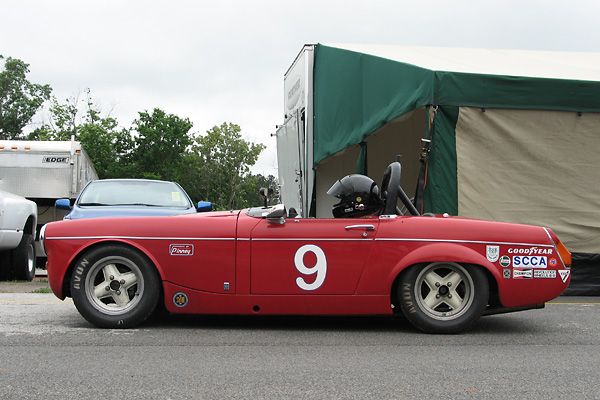
�
Derek Chima's MG Midget Race Car, Number 9
� Owner: Derek Chima� � City: Akron, Ohio
� Model: 1966 MG Midget
� Engine: 1275cc BMC A-Series
� Race prepared by: CC Motorsports�
�
History of the Mike Pinney MG Midget
��
This MG Midget was built by Jim Pinney for his son Mike in 1975. With it, Mike �
convincingly won SCCA's 1978 G-Production national championship.¹ After the �
race, Mike sold the Midget so that he could purchase one of the original Huffaker�
built MGB race cars. The Midget went to a local club racer in northeast Ohio, who �
only raced it about a dozen times over the course of three seasons. The engine and �
transmission were then removed and the car was stored from 1981 through 2001, when �
Derek Chima purchased it. �
�
Cosmetically, the car has hardly changed since 1978. From the front fenders �
rearward, it hasn't even been repainted. Derek wanted to preserve the look and feel �
of late-seventies racing, but nonetheless the car needed to be restored and brought �
up to date with current safety requirements. A few changes were also made to make the �
car more fun for vintage racing. Derek hired his brother Craig to handle these jobs. �
He couldn't have made a better choice! Craig has been building and racing Midgets �
(and other British sports cars) for over twenty-five years. Craig drove his own �
number-9 Midget to an F-Production SCCA national championship victory in 1994. �
Craig runs a race prep and restoration shop called CC Motorsports in Akron, Ohio.�
�
Derek's Midget was originally produced in very late 1966. It was one of the last Midgets �
built with a 1098cc engine. (MG made a running change and began installing 1275cc �
engines.) Depending on engine size, MG Midgets have mainly raced in three different SCCA �
"Production" classes. Derek's Midget raced in the middle one: G-Production. For �
vintage racing, the Chima brothers decided to install a 1275cc engine and �
thus move up to the F-Production class. �
�
Craig worked closely with George Bauchman of Midwest Motorsports in Toledo�
to get the engine just right. Over the years, these two friends have dyno tested�
a lot of engines together. They know what works. Bauchman built the cylinder head�
and provided the custom camshaft and pistons for Derek's motor.�
�
�
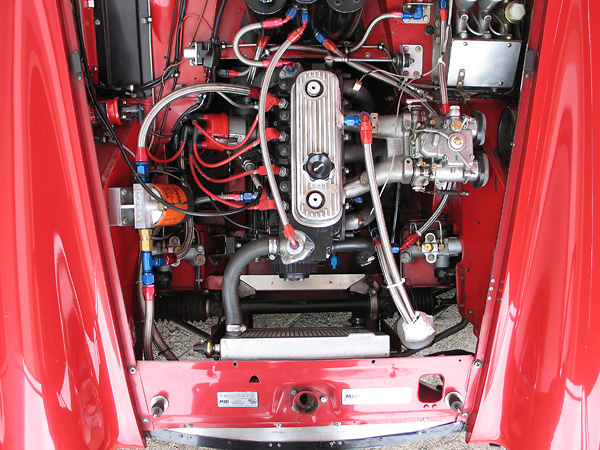
�
BMC A-Series 1275cc four cylinder engine, with Weber sidedraught carburetor.
�
Please support the sponsoring companies who make www.BritishRaceCar.com possible, including:
�
 �
�
�
Building an engine always involves a multitude of decisions based on intuition and on �
the customer's specific needs. For example, if you have a highly skilled driver and �
ideal gear ratios (in both the transmission and axle), and if you want your Midget to �
win an SCCA championship, you're probably going to want S.U. carburetors. Craig explains �
that S.U. carbs will usually produce demonstrably better peak horsepower on a fully �
race-prepped 1275cc A-Series engine that's turning 7500 or higher revolutions per minute. �
However, a Weber 45DCOE carburetor makes more sense for Derek's application because it �
suits a wider variety of conditions. For example, the Chima brothers are running one �
axle ratio all season long, instead of changing ratios to suit specific racetracks. �
(Bonus: starting the engine and driving across the paddock is a whole lot easier.)�
�
�
Enjoying this article? www.BritishRaceCar.com is partially funded through generous support from readers like you!
�
To contribute to our operating budget, please click here and follow the instructions.
�
(Suggested contribution is twenty bucks per year. Feel free to give more!)�
�
Craig custom built tuned "long center branch" headers for Derek's Midget. However,�
these aren't exactly the same headers Craig would install if he were building a Midget for �
SCCA racing today. The newer fashion is to carefully route the exhaust back through�
the differential tunnel so that the car can sit lower. (In SCCA racing this is a big �
advantage because competitors routinely move suspension pick-up points on the chassis�
to improve suspension geometry, while achieving a very low ride height. Vintage �
racers are generally required to leave suspension pick-up points on the chassis �
in their original location.) The custom headers on Derek's car are old-fashioned; they �
suit its conventional exhaust routing and higher ride height.�
�
In total, it took about a year to restore Derek's Midget to racing condition. The two �
brothers take it to a lot of races, and simply enjoy playing with the car. In 2009, �
we saw it run strongly at The Heacock Classic Gold Cup races at Virginia �
International Raceway and also at The US Vintage Grand Prix at Watkins Glen.�
�
Features and Specifications
�| Engine: | �BMC A-Series 1275cc four cylinder engine. Race prepared cylinder head, �
custom forged pistons, and custom camshaft by Midwest Motorsports.�
Weber 45DCOE carburetor, with short velocity stacks and screens,�
mounted on a Warneford 6" manifold (part# 3047). �
Mallory Unilite distributor. Mallory spark plug wires. NGK spark plugs.�
MSD6AL capacitive discharge electronic ignition. MSD Blaster 2 ignition coil. �
Mocal remote oil filter mount. Fram oil filter. �
Accusump 2 quart oil accumulator. Aluminum valve cover. | �
| Cooling: | �Ron Davis aluminum radiator. | �
| Exhaust: | �Craig built the custom long-center-branch exhaust header. Under-car exhaust system. | �
| Transmission: | �updated Richmond dog-ring, close ratio, 4-speed transmission. | �
| Rear Axle: | �stock housing. 4.22:1 gears. Tran X plate-type limited slip differential. | �
| Front Susp.: | �World Wide Imports adjustable racing shock absorbers.�
Lowered 650#/inch springs. 7/8" front sway bar. Delrin bushings.�
Aluminum front hubs. Tapered roller bearings (both inner and outer races).² | �
| Rear Susp.: | �three leaf gull-wing leafsprings. Panhard bar. �
Carrera telescoping shock absorbers. | �
| Brakes: | �(master) dual Girling master cylinders with bias bar, � (front) stock rotors and calipers. � (rear) stock drum brakes with Winners Circle Kevlar shoes. | �
| Wheels/Tires: | �Revolution aluminum alloy wheels with Avon tires. | �
| Electrical: | �Duralast lead/acid battery. | �
| Instruments: | �(left to right)Westach dual EGT gauge (400-1600F),�
AEM "UEGO" air/fuel mixture gauge (11-17:1), �
Smiths mechanical-drive tachometer (0-8000rpm, counterclockwise),�
Stewart Warner fuel pressure gauge (0-10psi),�
Stewart Warner water temperature gauge (100-265F),�
Stewart Warner oil temperature gauge (140-325F),�
Stewart Warner oil pressure gauge (5-100psi). | �
| Fuel System: | �ATL fuel cell. Dual Facet (Bendix-style) electric fuel pumps. �
Holley adjustable fuel pressure regulator. | �
| Safety Eqmt: | �Sabelt 5-point cam-lock safety harness. RCI (Racer's Choice Inc.) low back racing seat.�
Quick release steering wheel hub (installed on a Momo steering wheel).�
Firebottle centralized fire suppression system. | �
| Performance: | �in the 2009 "Collier Cup" all-MG feature race at Watkins Glen, Derek was �
lapping the track at 2:26.123, which represents an average speed of 83.766mph �
over the 3.40 mile circuit. (He finished third in class and sixth overall.) | �
| Weight: | �~ 1418 pounds. | �
| Racing Class: | �(formerly) SCCA G-Production. (Now) SVRA 1FP. | �
Engine Installation
��
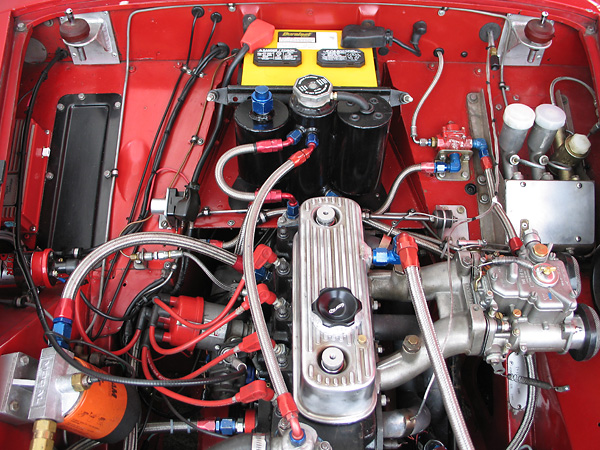
�
Midwest Motorsports built the cylinder head and provided the custom camshaft and pistons.
�
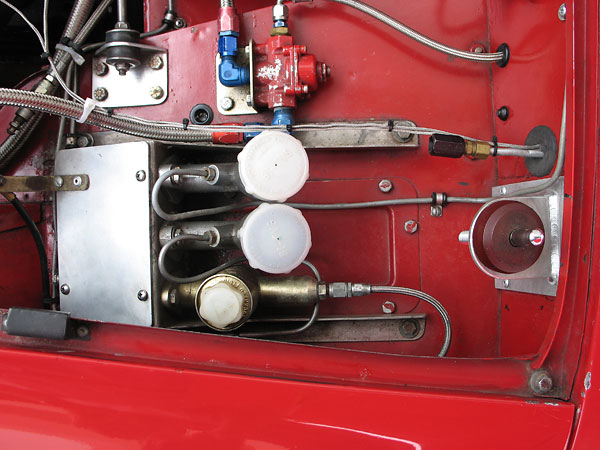
�
Dual Girling master cylinders with bias bar.
�
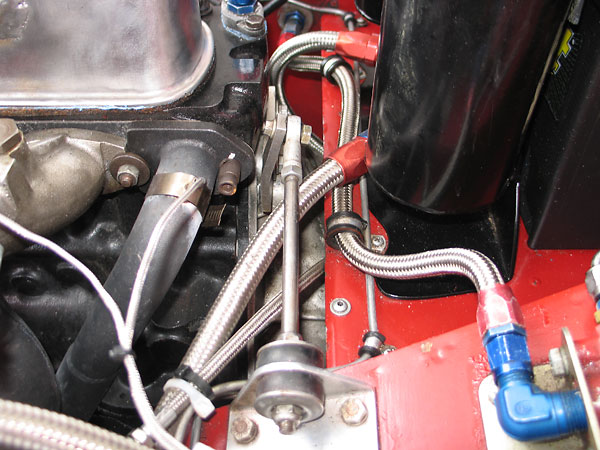
�
An engine steady bar absorbs torque reaction.
�
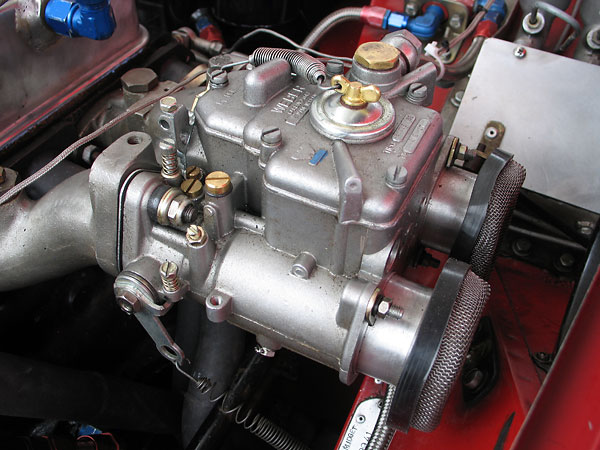
�
Weber 45DCOE carburetor, with short velocity stacks and screens.
�
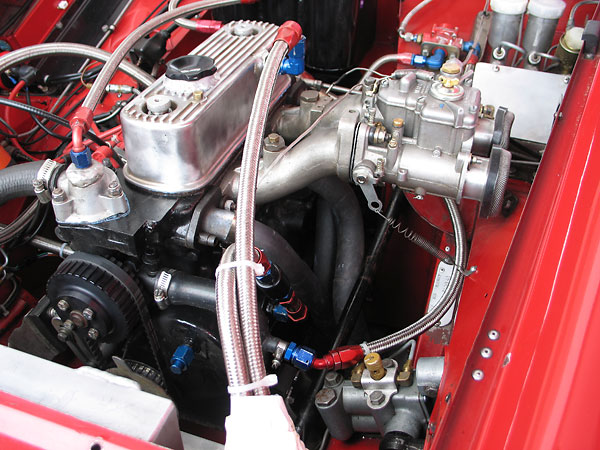
�
The aluminum intake manifold is a Warneford 6" model (part# 3047). These were made in Australia,
�
and are no longer available, but the same design is now marketed by Redline Performance.
�
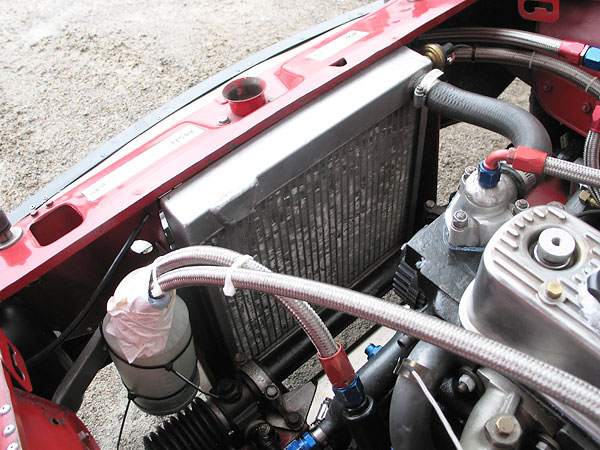
�
Ron Davis aluminum radiator.
�
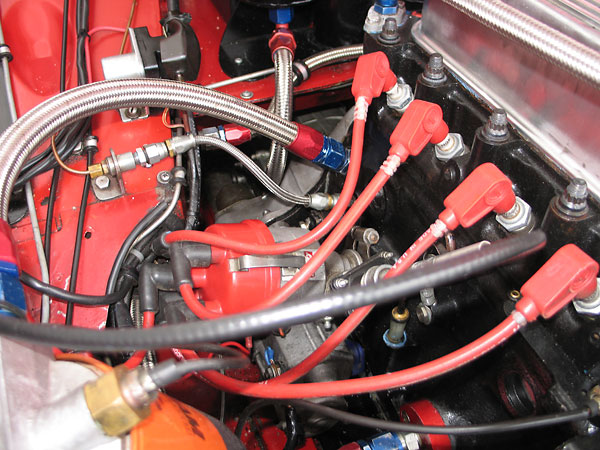
�
The mechanical tachometer's drive cable comes off the base of the distributor.
�
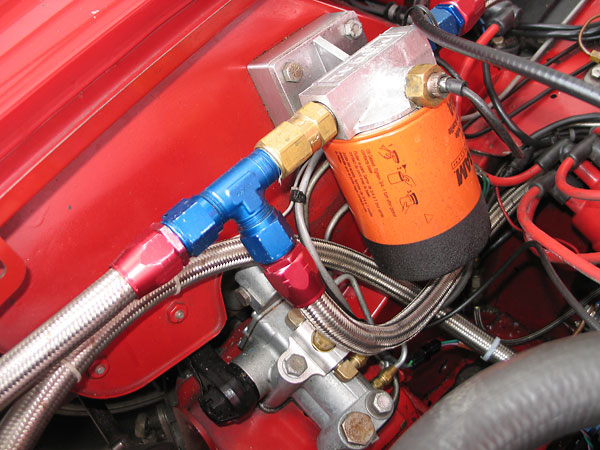
�
Mocal remote oil filter mount. Fram oil filter.
�
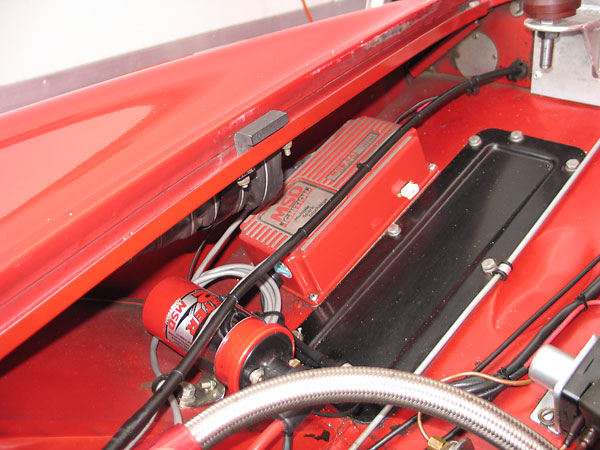
�
MSD6AL capacitive discharge electronic ignition and Blaster 2 ignition coil.
�
(Note: the MSD rev limiter was chipped at 6400rpm when we viewed the car at V.I.R.)
�
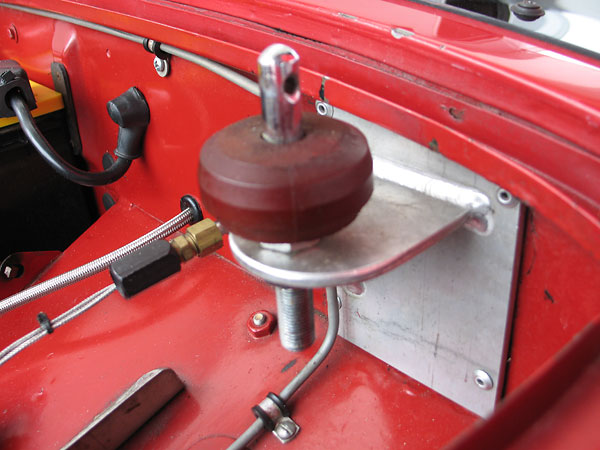
�
For better engine access, the bonnet is mounted on four hood pins instead of being hinged.
�
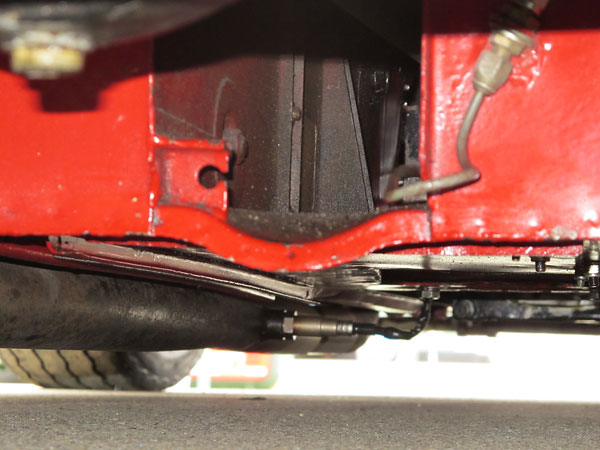
�
A wide-band oxygen sensor mounted on the exhaust pipe provides valuable data for engine tuning.
�
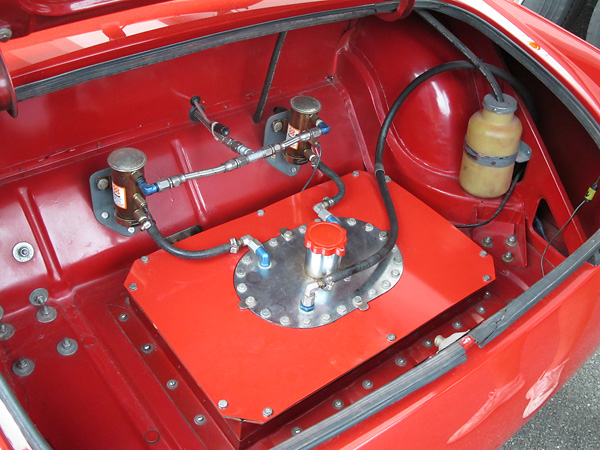
�
ATL fuel cell and dual Facet (Bendix-style) electric fuel pumps.
�
Front Suspension
��
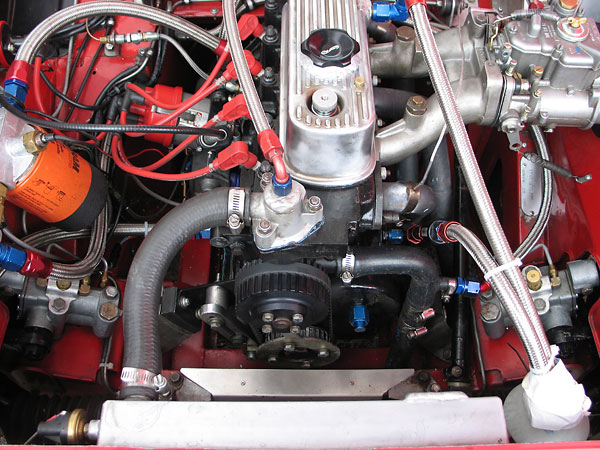
�
Craig says the World Wide Imports adjustable racing shock absorbers are the best money
�
can buy for an MG Midget without going outside the rules of vintage racing.
�
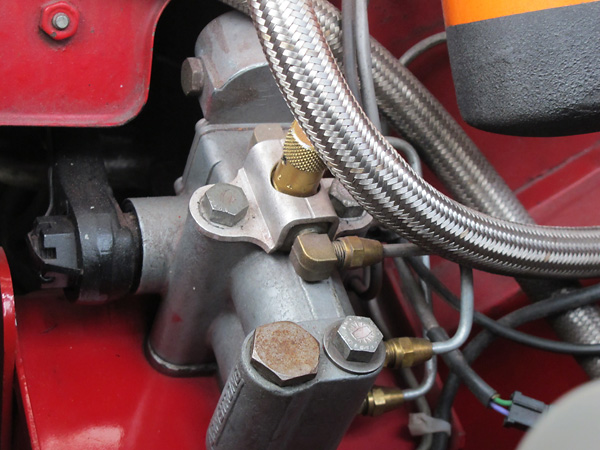
�
The remote mounted flow control valves have knurled brass knobs. Craig advises they're set rather firm.
�
Please support the sponsoring companies who make www.BritishRaceCar.com possible, including:
� �
 �
�
�
�
Rear Suspension
� �
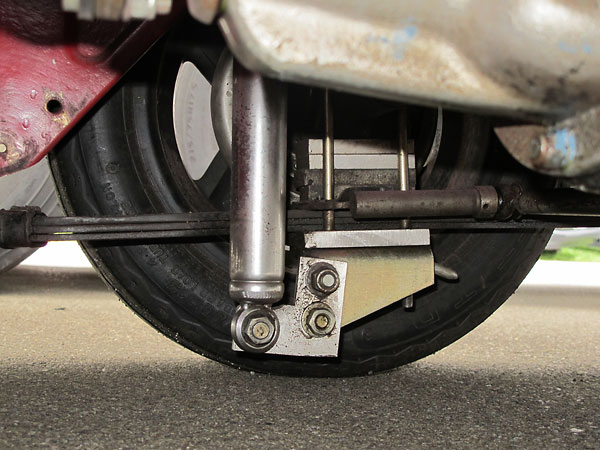
�
Carrera telescoping rear shock absorbers.
�
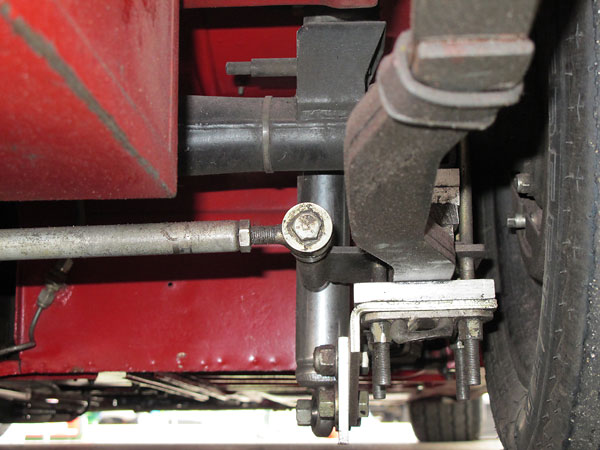
�
Three leaf gull-wing leafsprings provide needed tire clearance.
�
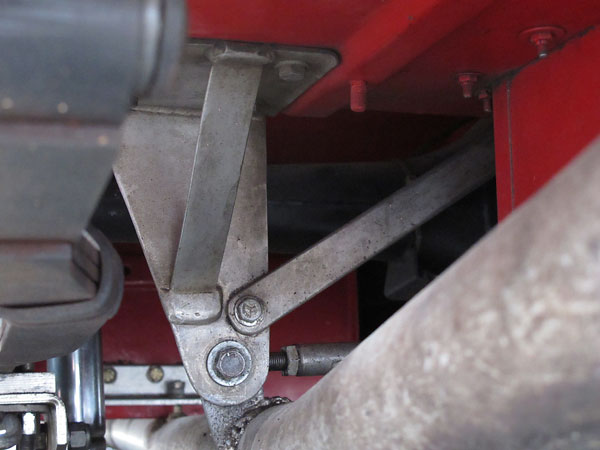
�
A custom Panhard bar (and brackets) keep the body nominally centered over the rear axle,
�
and lower the rear roll center. This bracket does double duty: it supports the tailpipe.
�
�
Interior
��
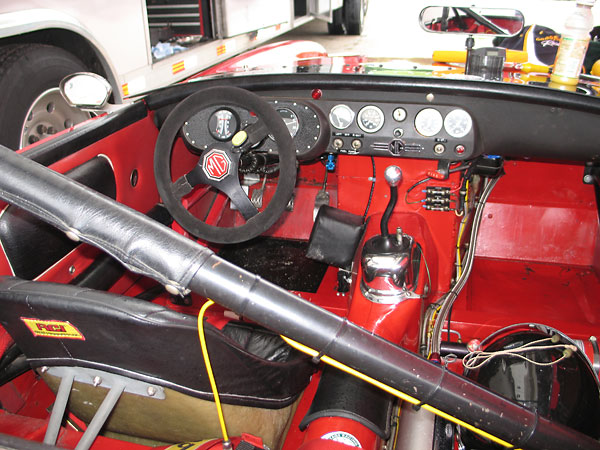
�
Despite their compact size, MG Midgets are surprisingly roomy to begin with.
�
For a racecar, this one is especially comfy! Room was left for adding a passenger seat.
�
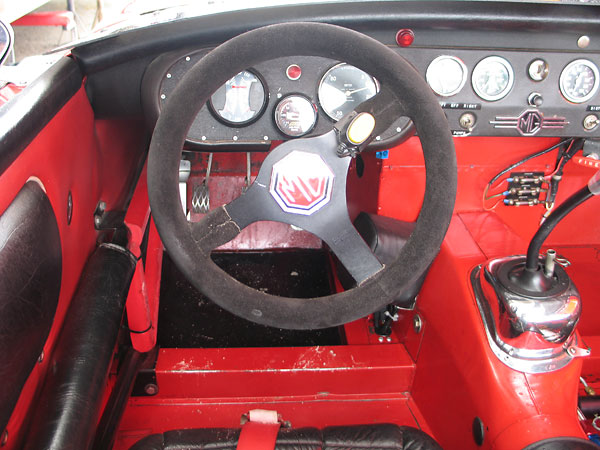
�
The yellow button on the Derek's Momo steering wheel is for his 2-way radio.
�
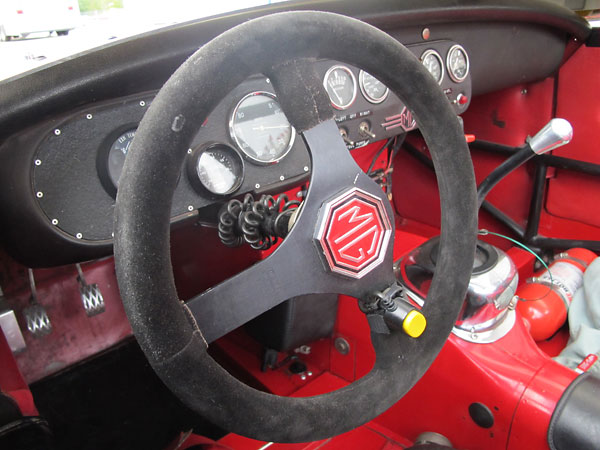
�
It's a dished steering wheel, reverse-mounted to provide a slightly more comfortable reach for Derek.
�
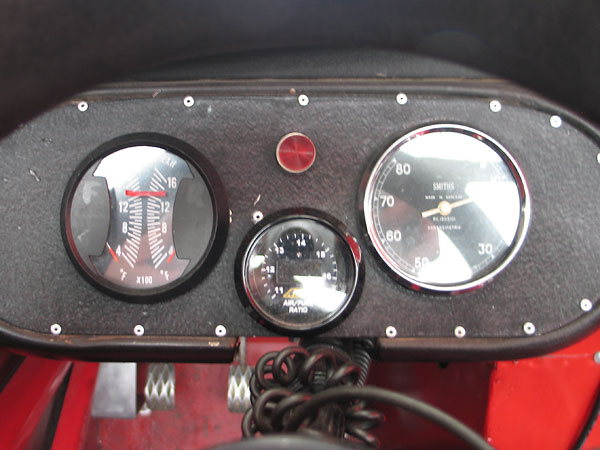
�
Westach dual exhaust gas temperature gauge and AEM "UEGO" air/fuel mixture gauge
�
are both very helpful for tuning the engine.
�
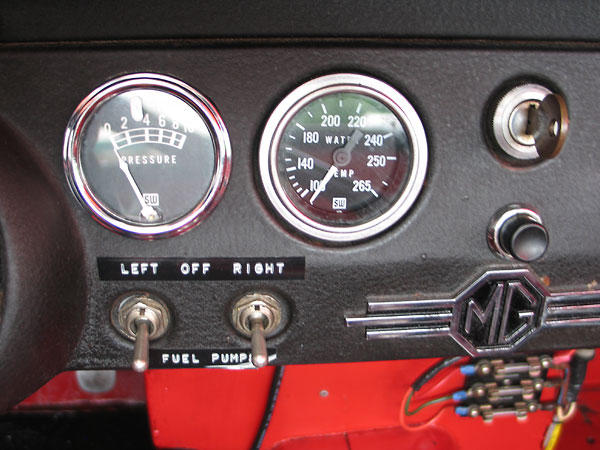
�
Stewart Warner fuel pressure (0-10psi) and water temperature (100-265F) gauges.
�
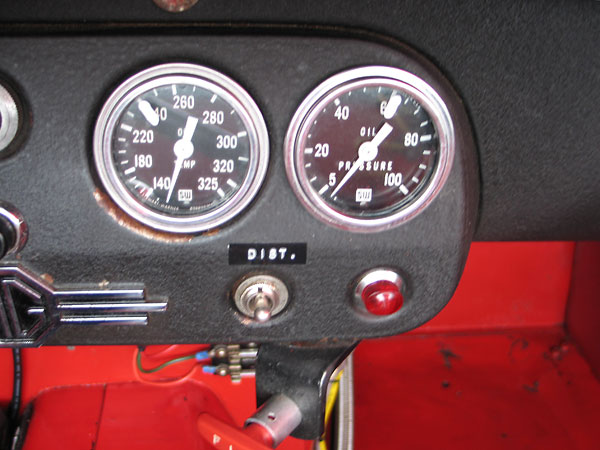
�
Stewart Warner oil temperature (140-325F) and oil pressure (5-100psi) gauges.
�
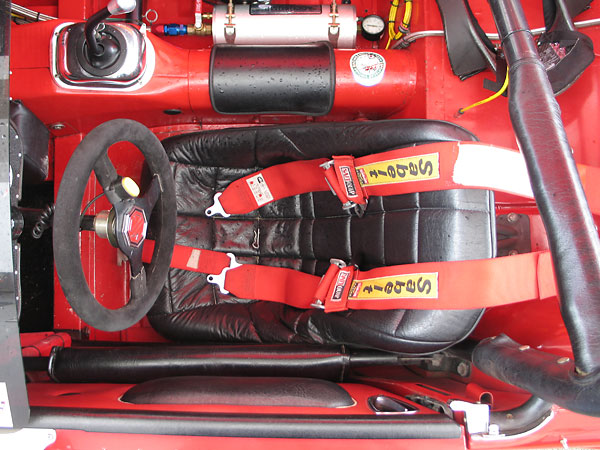
�
Pads for both elbows! At the top of the photo, you can also see the Accusump oil accumulator.
�
(It pre-lubricates the engine before starting...)
�
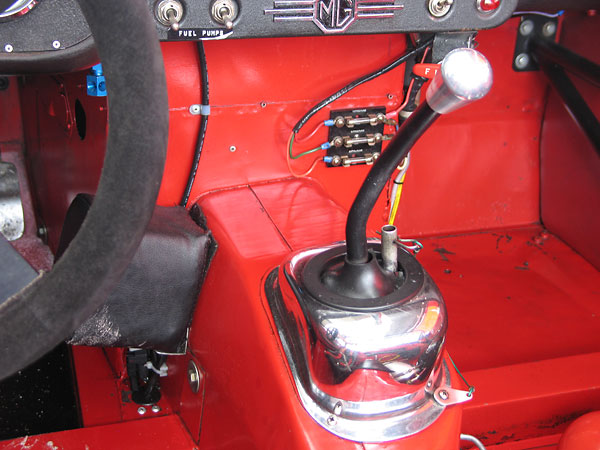
�
Gear shifter for the Richmond dog-ring, close ratio, 4-speed transmission.
�
�
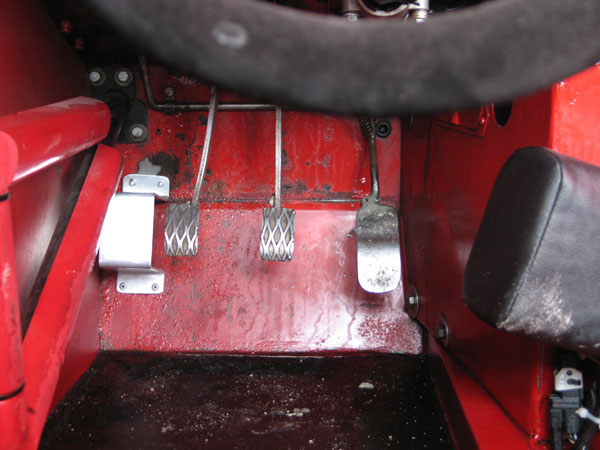
�
A "dead pedal" for the left foot and a generous pad for the right shin.
�
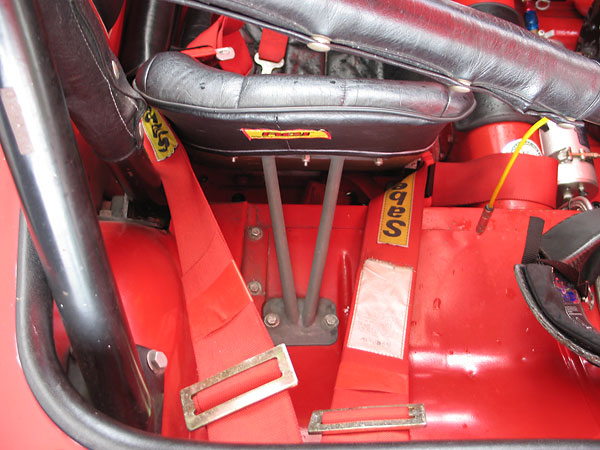
�
Sabelt 5-point cam-lock safety harness. RCI (Racer's Choice Inc.) low back racing seat.
�
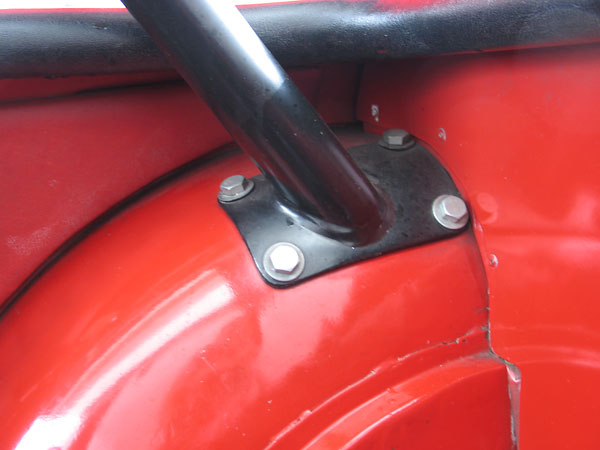
�
Jim Pinney designed and fabricated this custom roll hoop and its unusual side beams.
�
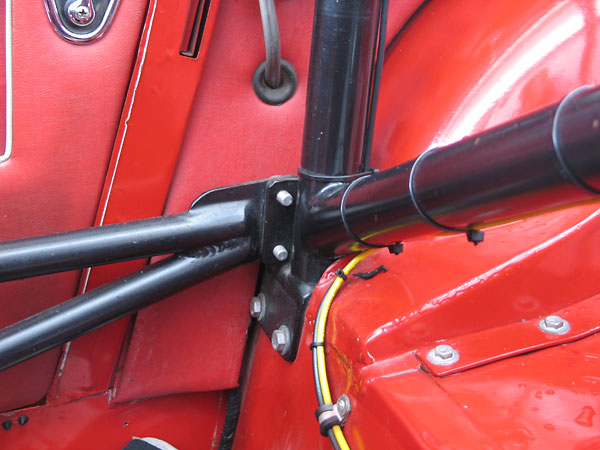
�
One feature of this safety structure is that it could be unbolted from the car and removed.
�
Also, the way it's designed, a passenger seat could easily be installed without interference.
�
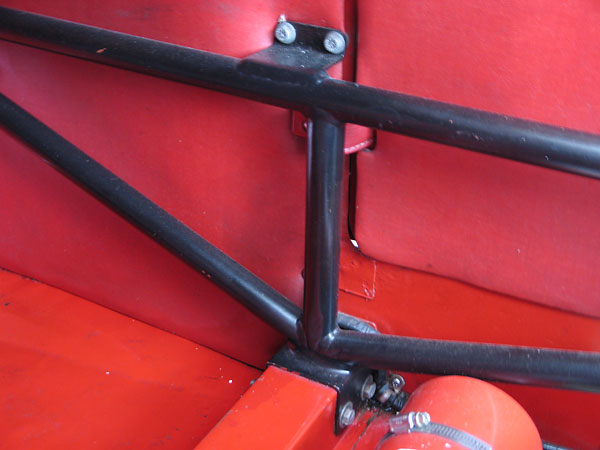
�
The side beams would provide more side-impact protection if braces were added across the cabin.
�
A handful of additional tubes could almost certainly significantly enhance torsional rigidity.
�
That said, obviously the car won a national championship without additional bracing.
�
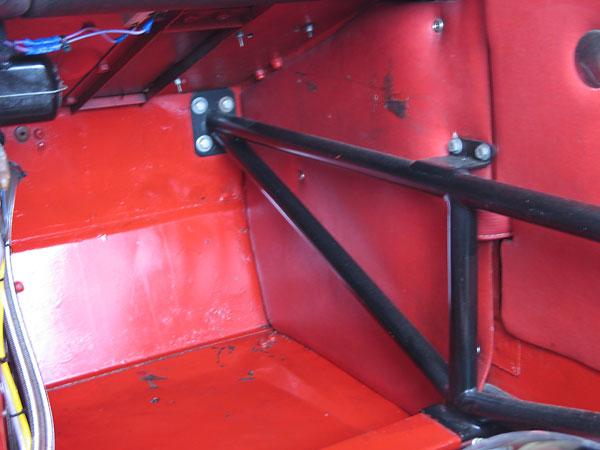
�
The craftsmanship of the fabrication work is uniformly exceptional.
�
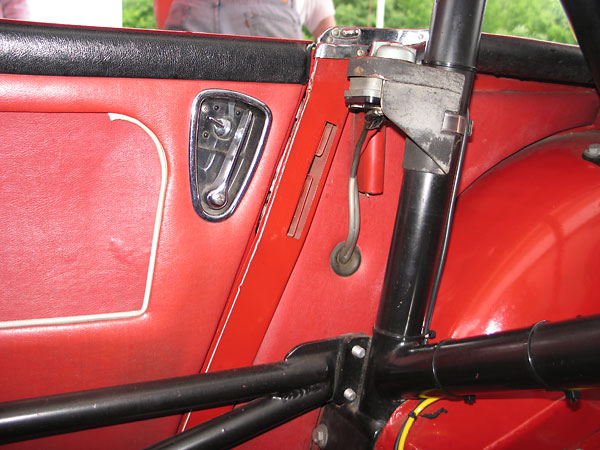
�
Emergency ignition kill switch.
�
�
Exterior
��
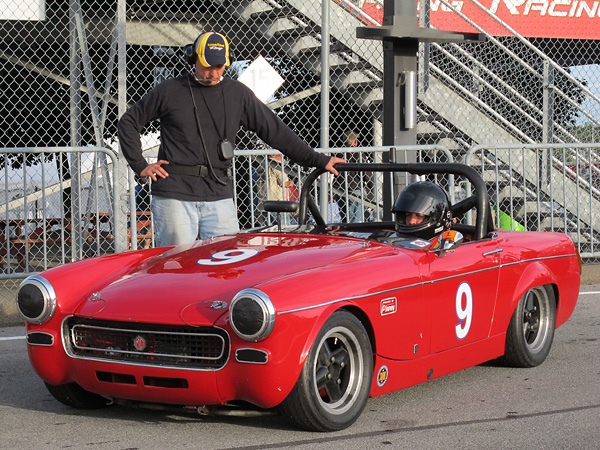
�
Derek Chima, and his Crew Chief (Craig Chima), ready to race in the 2010 Watkins Glen Vintage Grand Prix.
�
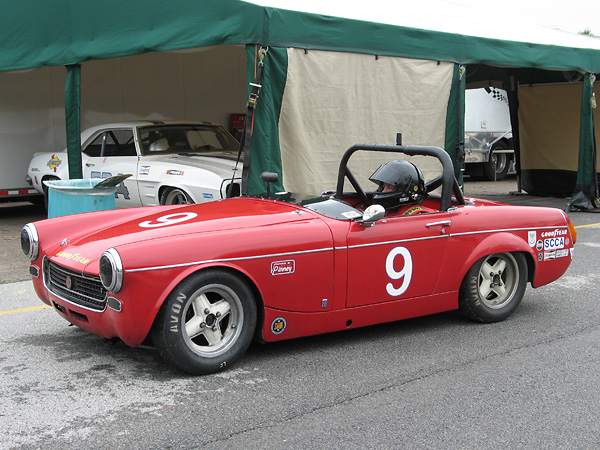
�
1978 Sports Car Club of America (SCCA) G-Production National Championship winning car.
�
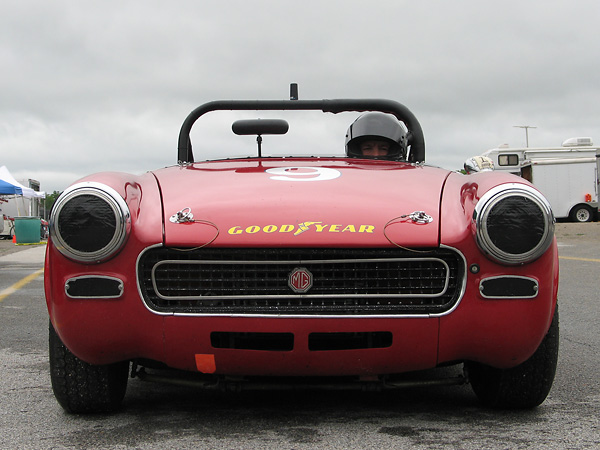
�
Racecars are so much more fun than concours restorations because racers routinely use their favorite parts.
�
Here, the grille is of the 1970-1974 style and the valance under it is from a (later) rubber bumper Midget.
�
(The difference is that it has two openings, whereas the original 1966 valance would have been solid.)
�
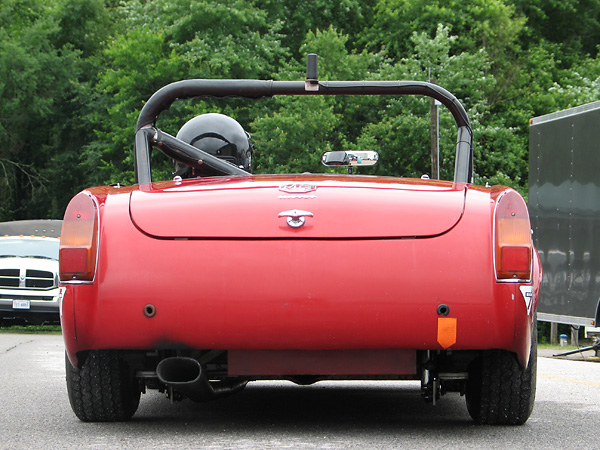
�
These tail light lenses are from a later model (1970 or later) MG Midget.
�
| Notes: | |||||||
| (1) | �
After the 1978 run-offs, Mike Pinney switched to racing an MGB with some success.�
He then took years off to focus on family and career, but racing was evidently �
still in his blood. He returned to racing in 2001, and won the 2002 SCCA �
F-Production championship with a 1275cc Midget.�
� | ||||||
| (2) | �
Stock MG Midget and Austin Healey Sprite front stub axles didn't come with tapered �
roller bearings! Back in the sixties, they probably didn't really need them. As �
racing Midgets cornered faster, due to more powerful engines and stickier tires, �
MG Midget stub axles began breaking. Stub axles should be Magnafluxed once per �
season to detect cracks early. Upgrading to tapered roller bearings is highly�
recommended for enhanced safety and durability. The correct way to do the installation �
is essentially the same way MG did it on the MGB model: a distance tube and spacer �
shims should be used to assure clearance between the two races of bearings, and the �
castle nut on the stub axle should be tightened to 60 foot pounds with a torque �
wrench. Setting bearing clearance by tightening the castle nut snug and then backing �
it off so many turns (as done on older American cars) is certainly not recommended. �
� | ||||||
�
Most photos shown here are from June 2009, when we viewed the car at The Heacock Classic Gold Cup at �
Virginia International Raceway. Where noted in captions, we've included additional photos from the�
2010 Glenora Winery / Watkins Glen Vintage Grand Prix. All photos by Curtis Jacobson for�
BritishRaceCar.com, copyright 2010. All rights reserved.
�
| If you liked this article, you'll probably also enjoy these: | �|||||
 | �
Chuck Pitt 1968 Spridget | �
 | �
John McCue 1972 Midget | �
 | �
Craig Chima 1964 G4 | �
| You're invited to discuss anything you've seen here on The British Racecar Motorsports Forum! | �|||||
�
Notice: all the articles and almost all the photos on BritishRacecar.com are by Curtis Jacobson.
�
(Photos that aren't by Curtis are explicitly credited.) Reproduction without prior written permission is prohibited.
�
Contact us to purchase images or reproduction permission. Higher resolution images are optionally available.
�

 �
�
